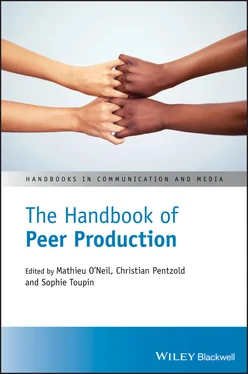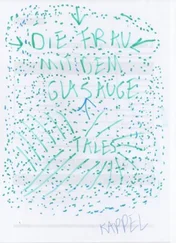1 ...7 8 9 11 12 13 ...46
11 Governing for Growth in Scope: Cultivating a Comparative Understanding of How Peer‐Production Collectives Evolve
Rebecca Karp, Amisha Miller, & Siobhán O’Mahony
Scholars have been fascinated by the rise of peer‐production collectives and how governance mechanisms can foster or inhibit the growth of new contributors. Few scholars have attended to what explains changes in the scope of innovation activities peer‐production collectives assume. We identify five roles that peer collectives can play in the innovation lifecycle, from idea generation to post‐production review, and compare 12 mature peer collectives to understand how their scope evolved over time. Our provisionary comparative analysis suggests that peer collectives that expanded their scope were more likely to distribute governance rights to contributing participants through a more collaborative mode of production. We offer a framework for analyzing why peer collectives grow differently and articulate a research agenda that embraces a dynamic approach to examining how scope and governance evolves.
Part IV Cases: Realizing Peer Production
12 Free and Open Source Software
Stéphane Couture
Free and open source software (FOSS) was formally launched in the 1980s by Richard Stallman in opposition to proprietary or closed software. Its speed of development was boosted by the rise of the Internet in the 1990s, and Linux became the original example of crowd‐sourced “bazaar” production whereby the number of eyes “makes all bugs shallow.” This chapter presents the history of FOSS, its modes of production, and its impact on both the infrastructure of the network society and the culture and practices of peer production projects. It ends by addressing some of the challenges FOSS is facing, in particular in terms of developing sustainable models, enhancing diversity in participation, and negotiating its growing integration into market processes.
Jutta Haider & Olof Sundin
Wikis are often considered to be the core platform of peer production. This chapter brings together a broad range of research on wikis and Wikipedia from different disciplines. It delineates the central design principles and affordances of wikis and also pays attention to their historical development and embeddedness in society. Wikis are described as content management systems that allow for flexible collaboration without a defined content owner or leader. Users can modify the content and structure of documents directly in their web browser. Edits are usually archived and open to revision. This chapter pays particular attention to the most successful wiki‐based system, the non‐profit, online encyclopedia Wikipedia. As the chapter explains, Wikipedia actually contains a broad range of more or less individual wiki projects and has inspired a plethora of other endeavors, both open source and proprietary. The particular peer production model employed in Wikipedia is elucidated, and in the course also complicated, as is the role of Wikipedia in the contemporary commercial Internet. The chapter concludes by highlighting several tensions emerging from a wiki‐based peer‐production model, between amateurs and experts, human editors and bots, lay knowledge and academic knowledge, and the shaping of trust through external actors.
14 Participatory Cartography: Drones, Countermapping, and Technological Power
Adam Fish
An investigation into participatory cartography – amateur and collaborative mapmaking – exhibits how theories of peer production often neglect how collective collaboration is dependent upon the state and fuels corporate technological development. This chapter investigates four case studies of participatory cartography, using theories of new materialism and technological power to expose the links between volunteerism and capitalism. For example, the participatory mapping project OpenStreetMap and its links to technology companies such as Bytemark and CloudMade, the early days of the US drone hacker network transforming into the for‐profit companies 3DR and DJI, and the problems of inequality related to the Indonesian Dayak community countermapping projects offer vivid examples of how the autonomy of peer production can be limited by elite technological power. Also, the Global Positioning System, the most important technology for participatory mapping, is a highly costly platform financed by the state. The new materialistic approach taken in this chapter emphasizes the entanglements of technology, culture, and politics and the movement of power across these different domains. That peer production is dependent on extant forms of technological power does not extinguish its political potential. On the contrary, the materialism approach invites proponents of peer production to better respond to the inequities associated with elite domination of technological power.
Panayotis Antoniadis & Alekos Pantazis
In this chapter we identify a wide variety of learning projects, platforms, tools, and methodologies which could be characterized as “peer‐to‐peer” and present their main characteristics along three core dimensions (curriculum selection, learning process, and knowledge abstraction). We then discuss how p2p learning processes can be encouraged, facilitated, and supported by digital and physical infrastructures, keeping a critical outlook on the often‐hidden power asymmetries that are always present at the infrastructure level. We pay particular attention to the case of small intentional groups of adult learners, and to four exemplary case studies – two digital platforms and two physical spaces – with similarities and differences, which help us to deconstruct and critically analyze the different dimensions of identified p2p learning.
Morgan Meyer
Over the past few years, a plethora of terms have emerged to describe scientific activities in the life sciences that happen outside traditional institutions: biohacking, garage biology, DIY biology, DIY genetics, DIY medicine, DIY science, and so on. These movements have attracted a growing number of enthusiasts, from young students to professional scientists, from artists to aspiring entrepreneurs, from people with no technological background to computer hackers. This chapter reviews and discusses the key literature on the topic. It first provides an overview of the history, and the various practices of DIY biology. Thereafter it offers a few examples of DIY medicine. The chapter then discusses and analyzes some of the key issues of DIY biology: the openness of the movement; what the “yourself” in do‐it‐yourself stands for; and concerns with ethics and governance. The penultimate section of the chapter looks at the economic aspects and the valuations of DIY biology. The conclusion will argue that further academic work could look into the geographies and fragilities/instabilities of DIY biology, as well as its relationship with the public.
Yana Boeva & Peter Troxler
Makers have engaged with different practices of peer production for the last two decades. Given access to electronic prototyping tools, digital fabrication tools, biohacking equipment, as well as different craft techniques and materials, makers exchange their knowledge on‐ and offline signaling bottom‐up processes of design, production, and education. The so‐called “maker movement” would bring about the democratization of technology and user emancipation by its prospect of personal fabrication and peer collaboration. Given the multiplicity of maker identities and what making has achieved, in this chapter, we tentatively define makers as individuals creating idiosyncratic artifacts in the form of most often hard‐ and software fixes to actual problems and challenges. The chapter provides a critical overview of the different cultures of making, their motivations as well as the socio‐technical infrastructures that encourage these forms of peer production. We outline a succinct and incomplete history of making in peer production. The chapter then explores the ways maker rhetoric and its diverse proponents have shaped making’s development and perception across the world. It discusses how the prospects of transforming users into makers and producers as well as the idea of makers representing a global social movement have unfolded since the year zero of making.
Читать дальше


![О Генри - Справочник Гименея [The Handbook of Hymen]](/books/407356/o-genri-spravochnik-gimeneya-the-handbook-of-hymen-thumb.webp)









